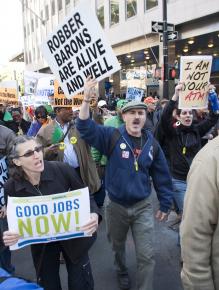Sending a message in New York City
reports on the latest budget-cut assault in New York City--and plans for a new round of demonstrations by unions and other groups.
A GROWING movement against budget cuts in New York City is headed toward a showdown with Mayor Michael Bloomberg and Gov. Andrew Cuomo.
Public-sector unions are organizing for major demonstrations at City Hall on the afternoon of June 14, and other activists have called for a sleepover to continue overnight, on the model of the occupations of public squares in Spain and other European countries.
Bloomberg and Cuomo have put forward budget proposals for the city and state that would have a devastating effect on schools, health care, housing, child care services and more--all programs that poor and working-class New Yorkers rely on.
Cuomo's budget plan passed the state legislature in April. His proposal cuts $10 billion for the next fiscal year, with further reductions of $13 billion, $15.4 billion and $17 billion in the following years. This year alone, school aid and the state's Medicaid health care program will both lose nearly $3 billion each, and the cuts are even sharper for other programs. Reductions in spending account for nearly 90 percent of the governor's plan to close the state's budget shortfall.

Meanwhile, the New York City Council is in the midst of hearings on Bloomberg's proposals, with the aim of passing a budget by the end of June. Bloomberg's plan has angered many New Yorkers with its severe cuts--especially teachers, parents and students at public schools, where the mayor wants to eliminate more than 6,000 teaching positions, reducing the number of teachers in the public school system by almost a tenth.
Other proposals that have sparked discontent include closing up to 20 firehouses and 50 senior centers, plus drastic cuts to child care centers and libraries. There also smaller agencies that face devastating cuts. For example, a program that treats sexual assault victims in public hospitals faces the loss of over half its budget. And of course, as in cities and states across the country, the politicians are also targeting the wages and benefits of public-sector workers.
Both Cuomo and Bloomberg justify their cuts by claiming that there isn't enough money to fund all the services that are currently in place. But neither man has done anything to make New York's powerful and wealthy elite pay anything like their share of the sacrifice.
Bloomberg could end tax breaks and subsidies worth $1.5 billion that go to Wall Street--at the same time as the country's six biggest banks are raking in a total of $200 million in profits every day. For his part, Cuomo's budget allowed for the expiration of the so-called "millionaire's tax"--a surcharge on New Yorkers who earn more than $200,000 a year. Continuing the tax would have brought in between $4 billion and $5 billion more in state revenues.
Opponents of the budget-slashers point to other measures that would put the burden of the crisis where it belongs--on the rich--like closing tax loopholes that allow Wall Street hedge funds to evade paying millions to New York City.
BUT THESE twin budget attacks have not gone without opposition.
At the end of March, a Day of Rage Against the Cuts brought more than 2,500 people to City Hall. A week later, when Cuomo pushed through his state budget, as many as 1,000 students, workers and community members surged into the Capitol building as the voting was taking place--an action inspired by the occupation of the Wisconsin Capitol building in February and March.
Then, last month, close to 20,000 people descended on the downtown New York City financial district as part of a protest organized by unions and activists groups. The demonstration was one of the largest labor protests in recent years, and one of the most militant--though union leaders did their best to divert the demonstration away from the Wall Street institutions that are the object of so many people's anger.
The June 14 demonstrations will hopefully be the strongest showing yet of opposition to the budget cut attacks.
AFSCME DC 37 says it will bring its members into City Hall to take their message directly to City Council members. The United Federation of Teachers will gather in Brooklyn and march across Brooklyn Bridge to join the demonstrations at City Hall. After that, a long list of activist and community organizations plan to stay at the City Hall site--which they've christened Bloombergville, in imitation of the Walkerville tent city that activists have organized in Wisconsin.
The next day, the New York City Central Labor Council and building trade unions are planning another march across the Brooklyn Bridge.
The unions and activist coalitions face important questions that have been hotly debated by those participating in the demonstrations. Union leaders have said they are willing to accept some layoffs and cuts, and hope to negotiate a better deal from Bloomberg and the City Council, but the activists' coalitions insist that no concessions would be necessary if lawmakers would tax the rich.
The June 14 demonstrations will likely be large, but if they are allowed to be a last symbolic showing, the growing anger against the cuts would be wasted. That's why many activists, including within the unions, are pressing for an ongoing campaign that includes more mass mobilizations and direct action, like the Bloombergville initiative.
Bloomberg and Cuomo want poor and working New Yorkers to pay the price for the economic crisis that Wall Street caused. But the demonstrations this week will send a clear message: No more cuts--it's time to tax the rich.


